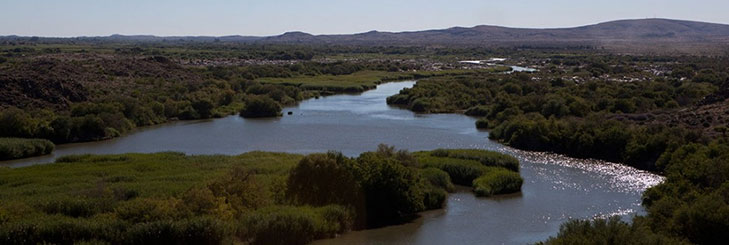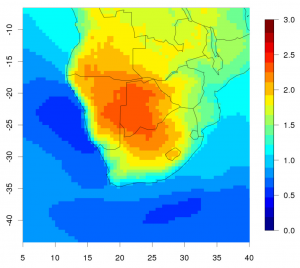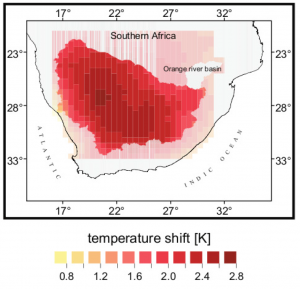Welcome to the first surface water quantity report of the Orange-Senqu River Commission (ORASECOM), for the hydrological year 2020-2021. For Read more
Categories
Latest Submission
2020-2021 Orange-Senqu Surface Water Quantity Synoptic Analysis
Khakea-Bray Transboundary Dolomite Aquifer Recharge Assessment
Documentation and Data: A read-only folder structure of all reports, data, and models related to the STAS can be accessed Read more
Improving Groundwater Knowledge in Selected Transboundary Aquifers
Documentation and Data: A read-only folder structure of all reports, data, and models related to this study can be accessed Read more
Stampriet Transboundary Aquifer System (STAS) – Governance of Groundwater Resources in Transboundary Aquifers (GGRETA) Project
Documentation: A read-only folder structure of all reports, data, and models related to the STAS can be accessed from here: Read more

Climate Change Impacts on the Orange-Senqu Basin (WP4)
- Author:Bennie Haasbroek
- Post date:27 January, 2014
- Categories:Climate,Surface Water Resources
Objectives
The Overall objective of Work package 4 was to carry out a detailed assessment of the occurrence, extent and possible effects of climate change in the Orange-Senqu River basin. This work involved the following:
- Detection of statistically significant change in the climate including an assessment of to which extent the detected climate change is consistent with the predicted climate change
- Identification of physically plausible explanations of any detected climate change
- Assessment of major adaptation needs in terms of water resource management, communities and economic activities, with a view to countering observed and/or expected impacts of climate variability and change on the hydro-climatology and water resources
Main Activities
The main activities undertaken as part of this work package were:
- Description of completed and ongoing climate modelling initiatives; assessment of their strengths and weaknesses
- Investigation into and recommendations on the most appropriate statistical methodology to detect climate change
- Identification of all possible sources of reliable climate data
- Statistical and Dynamic downscaling to reveal nature, extent and spatial coherence of climate change in the basin;
- Investigation of the possibility to develop stochastic models that capture key attributes of the climate’s past, present and future. Such models should be able to produce simulated time series as a step towards revealing changing probability of specific impacts on water resources
- Identification of water management adaptation requirements based on the identification of vulnerabilities of communities, economic activities and livelihoods to potential impacts of climate change
Conclusions
Based on available climate data (up to 2007), there is no clear signal of climate change (both
for temperature and precipitation) in the Orange River basin. Conclusive evidence is hard to
obtain due to the high variability of the local climate where natural variability tends to mask the more subtle influences of Climate Change. The downscaling according to the IPCC SRES A1B scenario yielded the following results:
2m Temperature
The two images in Figure below show the projected increase of the average 2m temperature (i.e. temperature taken at 2m above ground surface). The image on the left depicts the results from the dynamic climate model “CCLM” and shows the difference between the average temperature predicted for the 2031 to 2060 period compared to the actual temperature for the 1971 to 2000 period. The image on the right hand side depicts the results from the statistical climate model STAR. From 100 generated scenarios, the median wet scenario is shown (check full report for details). In this case, the projected average temperature for the 2051 to 2060 period is compared to the actual average temperature for the period 1958 to 2007. Both results suggest that there is likely to be an increase in temperature of approximately 2.5 °C in the central Kalahari areas. The increase in temperature is likely to be less severe towards the coastal areas.
Precipitation
Figure below shows three equally likely climate scenarios as produced by the statistical climate model “STAR”. The images depict the projected change in precipitation for the 2051 to 2060 period compared to the measured average precipitation for the 1958 to 2007 period. The results from the “CCLM” are not shown since they were not found to be reliable and further work in this regard will be required before such results can be used. Of the 100 scenarios generated by “STAR” a dry (5-percentile) is shown on the left, a median wet scenario (50-percentile) is depicted in the middle while a wet scenario (95-percetile) is featured on the right.
All thee realisations predict a decrease in precipitation for most of the basin while a slight increase in precipitation is possible in the eastern (Lesotho) portion of the basin. Since most of the runoff is generated in the eastern portion of the basin, the implications of the projected changes in precipitation may cause increased runoff in such areas. The overall impact of such climate change will have to be assessed through a more comprehensive assessment involving
rainfall/runoff modelling.
Recommendations
Downscaling
The downscaling can be improved with respect to several aspects. The “CCLM” could be finetuned for the region to include various technical improvements such as an improved convection scheme. Another possible strategy in the simulation of the local climate could be to carry out the long term simulation using “STAR. These runs then could be complemented by short term simulations with an improved “CCLM” which will generate extreme event scenarios. An improved “CCLM” could also be used to focus on specific areas by undertaking high resolution runs. Clearly the high runoff areas such as the Lesotho Highlands would be obvious targets.
Furthermore, the latest climate predictions suggested by the International Panel for Climate Change (IPCC) from the Global Climate Model (GCM) are due for release during 2011 which should help to provide greater confidence with the downscaling results.
Adaptation
In many respects the required adaptation measures will look similar to those measures which are already in place or proposed under the various water demand management initiatives.
- In the irrigation sector, crop water requirements will increase with the result that improved water conservation/demand management will become a higher priority
- The marginal farming areas will most likely become less viable with the result that alternative livelihoods may have to be sought if agronomic solutions cannot be found
- Improved management of the water resource. The total water resources may not decrease and could even increase if rainfall in the eastern source areas increases. It seems likely that the runoff from rivers taking their source further to the west will decrease, however, most of the Orange/Senqu water does originate from the eastern portions of the river basin.
An adaptive measure of a different kind is to improve the accuracy and reliability of climate change predictions by improving the input data. It is recommended that the climate station network in the source areas of the basin be improved both in terms of spatial coverage and the quality and detail of data.
Source:
Support to Phase 2 of the ORASECOM Basin-wide Integrated Water Resources Management Plan
Funding Organisation(s):
Date:
2011
Documents
Gerstengarbe, F. et al. 2010. Downscaling Methodology and ongoing climate modelling initiatives
Gerstengarbe, F. et al. 2011. GCC Downscaling for the Orange-Senqu River Basin
Crerar, S. et al. 2011. Projection of impacts under plausible scenarios and guidelines on Climate Change Adaptation Strategies






Comments
You must be logged in to post a comment.